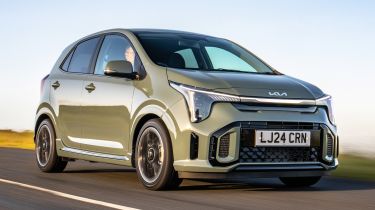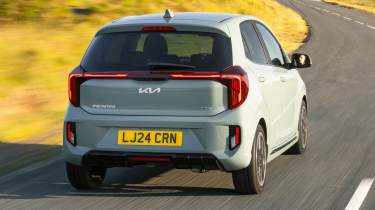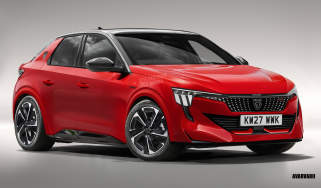New Kia Picanto 2024 facelift review: classy small car keeps big car appeal
Kia's revised Picanto city car remains a grown-up choice with plenty of appeal for buyers

Verdict
The facelifted Kia Picanto looks more premium and still features an impressive list of standard equipment. It drives like a bigger car, but it needs to because it’s more expensive than ever. For those in need of a tiny city car that don’t want to compromise on space, the Picanto remains a solid choice.
We don’t often talk about city cars anymore. It’s a sector in decline, as manufacturers look to electrify more profitable segments like SUVs and saloons. Indeed, there’s no more Volkswagen up!, Skoda Citigo or SEAT Mii, and the Peugeot 108 and Citroen C1 sister models were not revived with the latest Toyota Aygo X back in 2022.
Keeping the flame alive is the dinky Kia Picanto (plus its Hyundai i10 sister car) – and now the Korean city car has been given a mid-life facelift, which from the outside at least, looks pretty significant.
The front end has a squarer look with a similar front light signature to the new EV9 – still with the all-important ‘Tiger Nose’. The more imposing design was very much intentional; Kia knows the Picanto needs to attract buyers of the recently discontinued Rio supermini, as well as those who’d previously bought from rival manufacturers.
Daytime running lights have become ubiquitous throughout the automotive industry, but now it’s the turn of rear light bars – and despite being a tiny city car, the Picanto boasts one of these too.
More reviews
Not much has changed inside the new Picanto. The eight-inch touchscreen from high-spec models remains, as does the 4.2-inch driver’s display – both now standard on all trim levels. This might irk those that prefer a traditional set of dials, but the new set-up is at least clear in its layout.
Even on the entry-level 2 model, the general quality of the interior is good – certainly on par with many superminis. The Picanto 2 comes with black seats, but the 3, GT-Line, and range-topping GT-Line S receive black and grey artificial leather upholstery. The special edition Picanto Shadow gets a so-called ‘Adventurous Green’ interior.
Standard kit was always a strong suit for Kia’s city car and with the latest one you get a faux leather steering wheel, automatic headlights, rain-sensing wipers and 14-inch alloy wheels. Air-conditioning, USB-A and USB-C ports, rear parking sensors, a reversing camera and an impressive array of safety kit including forward-collision avoidance, lane-keep assist, hill-start assist and cruise control are standard too. The integrated sat-nav across all trims is a nice touch, but the black background makes it slightly difficult to read at a glance.
For a city car there’s a surprising amount of kit available on the top-spec GT-Line S with ambient lighting and even a sunroof. But our pick of the range is the car we tested – the mid-spec GT-Line. At £1,150 more than the standard ‘2’ model, you get the sportier GT-Line exterior styling package, coupled with 16-inch alloy wheels, LED lights front and rear, metal pedals, faux grey leather seats, and tinted windows.
Practicality is unchanged, which is a very good thing. Kia pushed the wheels to the corners of the Picanto to maximise interior space with the third-generation, resulting in rear passenger space that’ll fit a pair of six-foot-tall adults. Boot space is better than in the i10 (although only by three litres) at 255 litres.
The Picanto retains the same 62bhp 1.0-litre three-cylinder petrol offering from before, while the previous 99bhp turbo engine has been replaced by a new naturally-aspirated 77bhp 1.2-litre four-cylinder motor. Kia says it has been tweaked with new intake valve timing and improved cooling to improve efficiency, although it’s marginally thirstier than the i10 in equivalent trim. This engine is only available on the range-topping Picanto GT-Line S.
We tried the three-cylinder petrol in five-speed manual guise, which is just as well because even with its 15.4-second 0-62mph time, it’s still 2.8 seconds quicker than the automatic.
It might only have 62bhp and 93Nm of torque, but a sub-one-tonne kerbweight means the Picanto is fairly responsive and certainly nippy enough for city driving. It’s a reasonably flexible engine too, though revving it out to the 6,500rpm red line you’ll notice a drop off in power.
Happily, Kia has engineered a sturdy and confident feel to the gearshift, along with a sensibly-calibrated clutch pedal. Despite being a five-speed, the Picanto is short geared so you’ll find yourself changing gear regularly.
The overall inputs add to the big-car feel of the Picanto with weighty, yet quick steering and surprising stability at motorway speeds. The little Kia is also genuinely good fun on a tight back road, although it can feel a little lost in larger, sweeping corners.
Refinement is okay, but at high speeds there’s noticeable wind and road noise – the thrummy three-cylinder engine is a constant disruption too. The Picanto’s suspension is also compliant over most roads with only large speed bumps and potholes really unsettling the ride. It’s certainly capable of taking on occasional long journeys though.
| Model: | Kia Picanto GT-Line |
| Price: | £16,745 |
| Powertrain: | 1.0-litre three-cylinder petrol |
| Transmission: | Five-speed manual |
| Power/torque: | 62bhp/93Nm |
| 0-62mph: | 15.4 seconds |
| Top speed: | 90mph |
| Efficiency/economy: | 121g/km/52.3mpg |
| Size (L/H/W): | 3,605mm/1,485mm/1,900mm |
| On sale: | Now |











